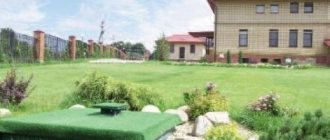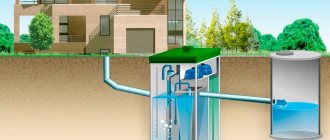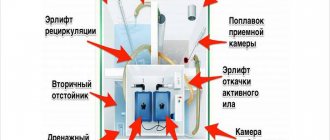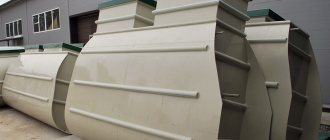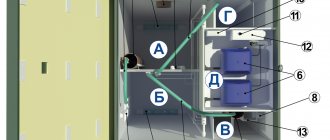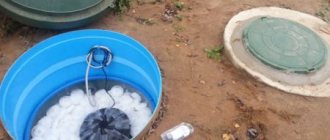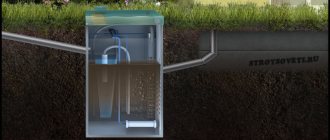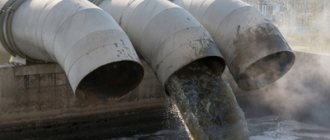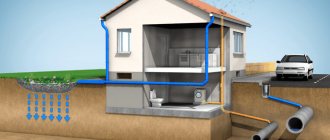In many private homes it is simply impossible to connect to the general city sewer system. In this regard, some people have to save on the amount of water they consume and endure inconvenience. To make life easier, you can use bioseptics for a country house, which make it possible to abandon cesspools once and for all, using as much water as necessary without polluting the environment. What is a bioseptic tank and can you install it yourself? Let's figure it out now.
Most types of septic tanks are devices that have a compact shape and low cost. Their quality is guaranteed by the manufacturers, and it fully meets all the requirements for sewage treatment in our time. Bioseptic tanks are autonomous treatment facilities that are ideal for filtering wastewater and carrying out its biotreatment using the aeration method.
What are the advantages of bioseptics?
- The service life of the tank is at least 30 years. This is due to the fact that the material used to make its body is stabilized propylene, which is resistant to corrosion and other harmful influences.
- The wastewater is purified almost 100%, so it can be safely discharged into nearby soil.
- Scheduled maintenance is required no more than once every couple of years.
- When installing a septic tank, you do not need to order heavy equipment, since the body of the septic tank is not heavy and has mounting loops.
- The treatment system operates without unpleasant odors, as is the case with conventional cesspools. This makes it possible to install septic tanks close to buildings (but not closer than the permissible distance).
- The cleaning system can operate without electricity in the event of a power outage.
- The compressor in a septic tank can work for at least 15 years (manufacturing country - Japan).
- Not all septic tanks operate only on electricity - you can order a septic tank that cleans wastewater without connecting to the electrical network.
- The housing is completely waterproof, so there is no need to worry about the penetration of untreated waste into the surrounding soil.
What is a bioseptic
A bioseptic tank or biological treatment septic tank is a device that allows you to accumulate and purify wastewater. This system consists of a plastic tank that is highly durable and has several tanks for wastewater treatment. Cleaning is carried out due to the activity of bacteria.
Bioseptic tank and septic tank have several differences. First of all, they are different in that the bioseptic tank has an additional purification system using bacteria, air and other reactions that help purify water up to 95-98%.
It is worth noting that in bioseptic tanks, various treatment methods are used for wastewater treatment, including mechanical, aerobic and biological treatment. It is also necessary to pay attention to the fact that in a bioseptic tank, wastewater undergoes up to 8 degrees of purification.
Application of a septic tank Zorde
It is installed in dachas and private houses that are not connected to the central sewer system. The Zorde biological treatment station purifies wastewater by 98%. The water from such a septic tank is clear and odorless; it is allowed to be drained onto the ground, into a ditch, and even into a reservoir. Thanks to this, the Zorde bioseptic tank can be installed not only in sandy soil with low groundwater, but also in difficult soil conditions: high groundwater level, clay, quicksand.
The only limitation during installation is that the Zorde septic tank should not be located further than 20-30 meters from the road, as it requires periodic pumping with a sewer truck.
The principle of operation of bioseptic tanks
It is worth noting that the operating principle of all septic systems is similar, despite the fact that their variety and quantity on the market is simply enormous. All septic tanks work on the same principle.
The operating principle of a bioseptic tank is to transfer water from one compartment to another, where various wastewater treatment processes are carried out. Ultimately, the dirty water from the bioseptic tank becomes industrial water, and can then be reused, for example, for irrigation.
Modern models of bioseptic tanks
- Eurobion - the design of a septic tank includes such elements as an air lift, three chambers, biofilm removal, a compressor and an aerator. The material used to make the container is polypropylene; all necessary components are included. The productivity of different models ranges from 800 to 25,000 l/day, which allows you to choose equipment for both a summer house and an entire cottage. The minimum length of the station is 1000 mm, width 1000 mm, and height 2330 mm. Treated wastewater can be discharged by gravity or pumped.
This is what the Eurobion septic tank looks like
- Topas is a self-contained, rectangular-shaped unit that is convenient and easy to use. The advantages of equipment from this manufacturer include: high efficiency, simple installation, small dimensions, wide model range, quiet operation of the installation. Disadvantages: energy dependence, rather high cost. The Topas septic tank device provides two-phase wastewater treatment.
Bioseptic "Topas"
- Eurobion - equipment involves wastewater treatment in various volumes. The technological features of Eurobion stations include high quality cleaning for all types of contaminants, the ability to operate at any time of the year and does not require conservation, the design is easy to transport and install. Moreover, it does not require the services of vacuum cleaners, and different modes of waste disposal are supported. And most importantly, the Eurobion bioseptic tank can function for several months without waste.
Water treatment with Eurobion septic tank
Do not forget that how the sewer system will function is reflected not only in how high-quality the bioseptic tank is chosen, but also in the correctness of its installation and operation.
Therefore, if you want to install it yourself, it would not hurt to watch thematic videos and consult with professionals in this field.
Bioseptic device
Bioseptic device
Bioseptic is a system that has several cleaning compartments, usually equipped with a ribbed (hard) surface.
Wastewater first enters the first treatment chamber, where mechanical treatment occurs. In this compartment, the water is purified from fats, surfactants (STEAM), which are included in almost all detergents, as well as large solid particles, which subsequently settle to the bottom. Next, the still dirty water flows into the second compartment, where the liquid is re-purified, the sludge that is at the bottom flows back into the first compartment, the water is re-purified and settled.
After this, it flows in small doses into the next compartment, where biological treatment occurs. At the end, the water flows into the next well, where the water settles for some more time and flows into the technical well (sink).
Septic tank installation
Construction of a septic tank for a country house
A conventional septic tank consists of three or four chambers. The first of these chambers receives water that is heavily polluted and has not gone through any stage of purification. The largest part of the contaminants settles in this chamber. In the next, second chamber, silt and pieces of debris that passed through the first chamber settle to the bottom. In the third chamber, all deposits undergo recycling and aeration. When the water reaches the last, fourth chamber, it is completely purified.
It is important to pay attention to the performance of the septic tank - this is the main criterion. If the productivity is low, then the septic tank will not cope with the volumes of wastewater entering it. However, this will not mean that the septic tank is faulty or poorly constructed. The whole problem will be that its performance was not determined when it was selected.
Septic tank with biofilter
A septic tank that has a biofilter consists of a small filtration field where water is purified from organic substances found in the wastewater. The filtration compartment is cleaned in two ways: mechanical and biological using special bacteria. Bacteria convert organic substances into harmless inorganic ones, which makes the wastewater cleaner and more harmless. Biofilters can be of two types:
- Aerobic, which do not require ventilation and the participation of air in the reaction process;
- Anaerobic are those that require special ventilation and a constant flow of air.
Autonomous Septic Tank
Kit contents
A septic tank (settlement tank) is an element of a local treatment plant on a private plot of land. Designed for collection, step-by-step purification and sedimentation of organic and mineral particles of domestic and industrial wastewater from suburban real estate. There are a lot of types of septic tanks today.
They consist of:
Settlement tanks. The chambers can be made from concrete rings, car tires, or made of natural bricks. Shape: round, rectangular, horizontal or vertical. There can be either several of them, two or more, or one chamber with a waterproof partition- Inlet and outlet pipelines. If the system provides for post-treatment of wastewater through a filtration field, then there may be no outlet pipeline.
- Ventilation systems;
- System maintenance devices (inspection hatches, inspection wells).
How does a septic tank work?
The general principle of operation of all types of septic tanks is based on the flow of sewage through connected vessels from one chamber to another. At the same time, the concentration of solid particles and impurities decreases, and the liquid fractions become lighter.
The general operation scheme of a septic tank primarily depends on the method of filtering liquid sewage. There are two cleaning methods:
- Anaerobic septic tanks with mechanical cleaning;
- Aerobic septic tanks with deep biological treatment.
Advantages and disadvantages of bioseptics
Biological septic tanks for wastewater treatment and storage have the following advantages:
- Environmental friendliness. They operate without harm to the environment, and the hermetic base makes it impossible for contaminated water to enter the soil;
- Ease of operation;
- Autonomous operation (does not involve other systems and tools);
- Reliability and durability. The service life of a bioseptic tank is approximately 40-50 years;
- Easy to install and install;
- Such septic tanks can be installed in any soil and even in a small area;
- Purified water can be reused to irrigate the site, and sludge and sediment can be used as fertilizer;
As for the disadvantages, they are:
- The cost of such a system.
- Maintenance and its cost. Purchasing biological products and pumping out solid residues will be quite expensive for the owner.
- The sewage system will have to be used constantly, since bacteria can die when water stagnates.
Despite the shortcomings, such systems are quite popular nowadays, as they are the best option for country houses.
Construction of the Zorde septic tank body
The Zorde body is made of homogeneous (solid) polypropylene 8 mm thick and has the shape of a cylinder. In production, a solid sheet of polypropylene is bent and welded. This creates one seam. It is made on a butt welding machine. The strength is the same as the material itself.
This form is more practical than a parallelepiped, as it better withstands soil pressure. In addition, silt does not accumulate in the corners below. At the same time, the bottom of the hull is square and has lugs. Thanks to its design, the septic tank does not float up if the groundwater level rises.
The warranty on the case from the manufacturer is 5 years.
Its neck is also round and is welded in production. In theory, if you make a mistake with a long neck, you can change it. But it is recommended to choose the right septic tank from the very beginning. To do this, call our measuring engineer to your site before purchasing. He will determine the installation location on the site, take all measurements, help you choose the right septic tank and draw up a detailed estimate.
Another design feature of the Zorde septic tank is the remote compressor module. Most often, at biological treatment stations, the compressor is located inside the station in the neck under the lid. Because of this, there is a risk of the compressor flooding if something goes wrong in the plant. Less often, the compressor is installed in a house in a technical room or in a non-residential building (shed, outbuilding). In this case, there is no risk of flooding, but you need to allocate space for the compressor, it is noisy and can get in the way. Zorda also decided to move the compressor unit outside the building, but there is no need to allocate a technical room for it - the compressor module is located not far from the septic tank:
Electrical equipment of the Zorde biorefinery station
A 40 W compressor is responsible for the operation of the station. Usually this is a Secoh or Hiblow, but can be any other compressor. The timer controls the operation of the compressor. By default, the timer is configured as follows: the compressor runs for half an hour, and rests for half an hour. But it can be configured differently. When the compressor does not work, aeration does not occur; wastewater settles in the station.
Warranty for electrical equipment – 1 year.
Since all overflows in the station are gravity-fed, the Zorde bioseptic tank can operate without electricity for 6-8 hours. At the same time, the quality of wastewater treatment will not decrease. However, this only works if:
1. The removal of clean water occurs by gravity (without electricity, the pump does not work).
2. At your dacha, the water supply also does not depend on electricity or there is a large supply of water in the system.
Otherwise, turning off the light will paralyze the work of water supply and sewerage in a private house.
Suitable septic tank for a private home: operating principle and design features
Before choosing a specific septic tank model, the design is evaluated based on the configuration and purpose of its constituent elements. There are different modifications, but most of them are characterized by the following components:
- Tanks for settling wastewater. Storage tanks are made of plastic, metal, concrete or brick. The most preferred models are made of fiberglass and polypropylene - the materials are resistant to abrasion and guarantee the tightness of the tank throughout its entire service life.
- Incoming and outgoing pipeline. Overflow pipes are installed at an angle, ensuring unhindered flow of liquid between the tanks.
- Service elements. Inspection wells and hatches. At least one well is installed on the external route of the sewer pipeline. When the length of the branch increases to more than 25 m, an additional revision is arranged.
- Ventilation system. Regardless of which bacteria (anaerobic or aerobic) are involved in the process of wastewater processing, air exchange is necessary for the normal functioning of microorganisms, methane removal and maintaining the desired temperature.
Septic tank: what is it and how does it work
By habit, all autonomous treatment facilities are called septic tanks. But this is not entirely true. A classic septic tank for sewage in a country house is a three-chamber container in which light and heavy fractions, gases, suspended matter and all other impurities are alternately separated from wastewater. After the completion of the cleaning cycle, the liquid enters the filtration field, where final cleaning is carried out. The outlet water is purified by approximately 50-60%. A bioseptic tank with an additional filtration stage is called a bioseptic tank, or sewerage station. Their main difference from a conventional septic tank is the number of chambers (6-7), the degree of purification of 98% and the presence of a compressor. In a sewerage station, the environment is ideal for the existence and activity of special microorganisms that destroy all organic impurities.
The difference between a septic tank and a bioseptic tank primarily lies in the degree of purification of the processes occurring during cleaning. Inside the septic tank the processes are anaerobic, and inside the bioseptic tank they are aerobic. But we’ll talk about the advantages and disadvantages of each type of treatment facility a little later.
